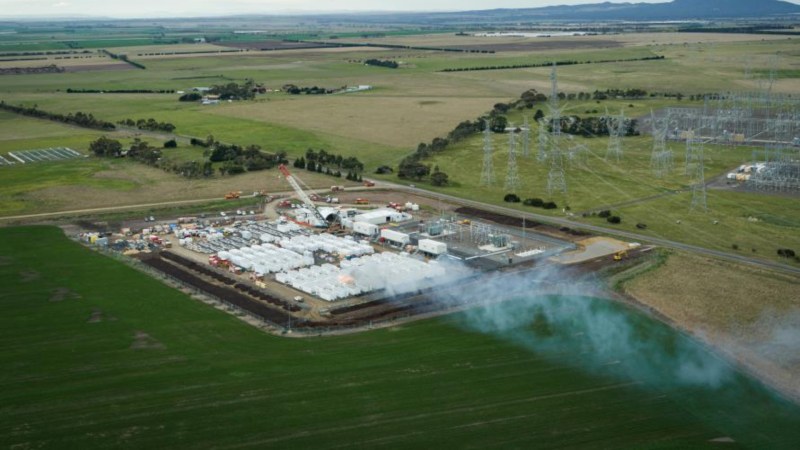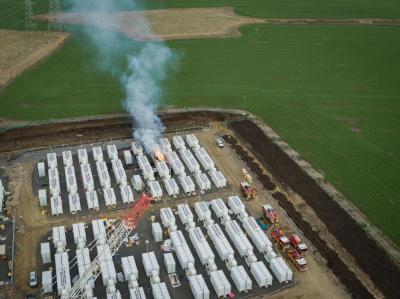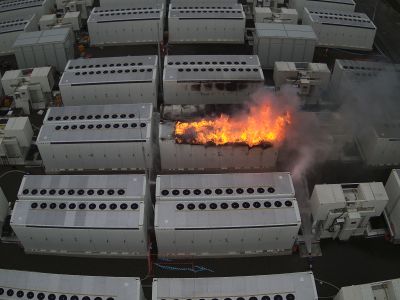
Lithium rechargeable batteries have been heralded for their high-density energy storage, enabling all manner of technologies to come to fruition. From drones to practical electric cars to large-scale grid storage, the applications are endless.

However, the lithium rechargeable battery has always had one major flaw–flammability. Pushed outside their operating range or otherwise tipped into thermal runaway, and they can burn ferociously as a result.
This came to pass in late July, at the Victorian Big Battery in Geelong, Australia, and it took significant effort to extinguish the blaze. Let’s take a look at the project and see how this came to occur.
Grid-Scale Storage
The Victorian Big Battery is a grid storage project similar in construction to the Hornsdale Power Reserve in neighboring South Australia. However, where the Hornsdale facility fields 194 MWh of capacity and 150MW peak power delivery, the new project aims to go much further. The Victorian project aims to install 450 MWh of capacity and deliver a peak power output of 300 MW.

Operated by Neoen, the facility is built using Tesla Megapacks, large battery installations designed for grid storage purposes. Each Megapack contains batteries, inverters, and thermal management systems inside for a turnkey, plug-and-play solution to grid storage.
Initial testing of the battery was undertaken on July 30, with fire breaking out at approximately 10:15am according to official reports. The site was quickly disconnected from the grid with no interruption to the local electricity supply.
The fire burned for days, with firefighters announcing the blaze had been brought under control by 3PM on August 2. Lithium batteries tend to burn quite fiercely, and will often reignite after a time, so crews were left on site to monitor the battery for some time afterwards. Temperature readings were taken every two hours so that any heating or reignition could quickly be subdued.
Water Was Used, But Not Directly on the Fire
The fire was fought by the members of the Country Fire Authority as well as Fire Rescue Victoria. CFA incident controller Ian Beswicke spoke on the blaze, noting the difficulty of tackling such fires. “They are difficult to fight because you can’t put water on the Megapacks… all that does is extend the length of time that the fire burns for.” Acting on advice from Tesla, Beswicke noted that “…the recommend process is you cool everything around it so the fire can’t spread and you let it burn out.”

The fire began less than 24 hours after the battery began operating on the grid, according to sources quoted by the Sydney Morning Herald. Quick action by firefighting crews kept the entire facility from burning down, limiting the flames from spreading beyond a second battery pack.
Out of an abundance of concern for people in surrounding areas, a warning was given to those downwind of the incident. Two mobile units were deployed to the area by the Environment Protection Authority of Victoria. Despite early concerns and a warning for residents to shut windows and remain indoors, official reports soon gave the local atmosphere the all clear.
Obviously, a large fire lasting multiple days in a grid storage facility is an outcome that nobody wants. However, the events that followed serve as an indicator that authorities were well prepared to deal with the situation. No injuries were reported throughout the incident, and the fire was contained to a limited area of the facility. Only two battery packs caught fire out of the many on site (210 are planned in total), and electrical risks were properly managed to avoid disaster.
Questions remain as to how the fire started in the first place. Whether it comes down to an installation error or faulty equipment or batteries will likely be revealed by investigators in due time. For now, it’s a black mark against Victoria’s new battery project. However, in time, it may serve as an example of how through proper emergency management, lithium battery fires can be managed safely. The future of the electrical grid, and indeed, personal transport, may depend on it.
0 Commentaires